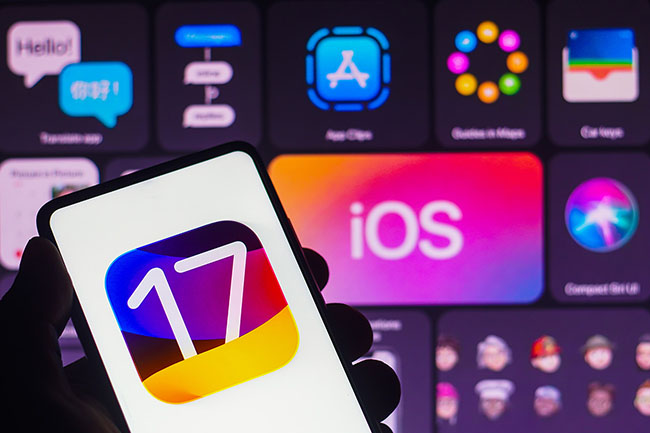iOS 17 brings lots of new stuff for iPhone users to enjoy. There are cool features for better communication and easy sharing of content. However, there’s a catch – iPhone 8, iPhone 8 Plus, and iPhone X won’t get updates anymore, showing a change in what iPhones are supported.
But wait, there’s more. For marketers, things are getting tricky. Apple already threw a curveball with privacy changes in iOS 14.5, and now, with iOS 17, it’s even more challenging. The new Link Tracking Protection feature is like another hit for marketers who use tracking data to see how well their campaigns are doing across different platforms.
In this article, we’ll talk about iOS 17, what it means for marketers, and share some tips on dealing with these changes.
Understanding iOS 17 Update
The iOS 17 update brings significant changes for iPhone users, but there’s a catch – older models won’t get support from Apple during the update process. Only users with iPhone XR, iPhone XS, or the latest models can enjoy the full range of iOS 17 features, with some limitations depending on the device’s capabilities.
In addition to the major iOS 17 release, Apple is rolling out incremental updates like iOS 17.2 and iOS (no specific version mentioned). These updates introduce various improvements, including enhancements to the Journal app, better AutoFill for PDFs, a catch-up arrow in messages, contact key verification, and more. Regularly updating to the latest version ensures users receive up-to-date security patches, bug fixes, and new features weekly.
One noteworthy feature causing a buzz among marketers is ‘Link Tracking Protection.’ This new addition automatically removes user-identifiable tracking parameters from URLs when users browse in private mode on Safari or use Apple’s Mail or Messages. The goal is to give users more control over their online privacy by eliminating certain URL parameters that enable tracking across different websites.
With these iOS 17 updates among others, businesses should rely on the advice of digital marketing experts.
What is LTP and How Does It Impact Marketers?
Link Tracking Protection (LTP) in iOS 17 adds massive obstacles to marketing by limiting the delivery of critical UTM parameters such as gclid, dclid and fbcli ds which are essential for effective cross-platform tracking. These limitations seriously limit the potential of marketers in obtaining a detailed picture about their campaigns, which does not allow fine-tuning targeting strategies and distorting data on users’ behavior.
The commitment of Apple to user privacy through LTP calls for a paradigm change in the ways that marketing strategies are conducted. Marketers must adjust to this by looking at other means of tracking, utilizing first-party data and paying attention on how the privacy standards are changing. With the uphill battle that iOS 17’s privacy-centric updates pose, successful campaign tracking and optimization become virtual necessities for embracing innovative solutions.
How does iOS 17 Impact Marketers?
The effect LTP in iOS 17 has on marketing is immense, especially with its significant functionality of removing user-identifiable parameters from URLs when browsing privately within the Safari browser – and this includes over a billion people. This functionality makes it difficult for marketers as the tracking of user interactions across platforms emanating from ad campaigns is directly hindered.
In essence, the interruption of LTP disrupts a smooth data stream that is key to understanding user behavior and engagement potential as well assessment of marketing strategies’ effectiveness.
While UTMs manage to maintain their functionality and preserve some of the tracking aspects such as data associated with Google Ads and Campaign Manager can be considered lost.
All the valuable insights include but are not limited to query match type, ad group details, final URL information related metrics of an advertisement format specifically together with parameters of distributed network and placements domain data up to Google Ads customer ID. The lack of such granular details limits the ability marketers must conduct more in-depth analysis, optimize campaigns, and adjust strategies based upon detailed and accurate data.
But this shift in iOS 17 sets a new standard for marketing – an innovative approach to data analysis and campaign optimization. Adapting to the restrictions imposed by Link Tracking Protection entails more than just managing privacy issues of users or even devising methods for continuing effective targeting, tracking and optimization as the world of digital marketing evolves.
Strategies for Marketers in Response to iOS 17 Changes
As the popularity of iOS 17 spreads, marketers are faced with an urgent obligation to advance their approaches in a preemptive manner or tailor them to fit the changing digital terrain and adapt their digital marketing strategy.
Making Sure Things Work: Checking Links and Stuff
Marketers need to be sure the links they send through Mail in iOS 17 still work well. Running tests helps find and fix any issues. They also need to check if their websites work properly in private browsing mode, covering things like logins and special APIs.
Apple PCM: Privacy and Knowing What Works
Private Click Measurement (PCM) is a tool that helps marketers know if their ads are working without knowing who clicked on them. PCM is useful for understanding ad clicks, especially in Private Browsing mode. Marketers should use PCM to make changes in how they measure ads.
UTM Parameters: Keeping Things in Order
Marketers should use UTM parameters to keep track of how well their ads are doing. With iOS 17, this becomes even more important. Following the rules and using tools like PCM helps keep ad strategies in good shape.
Tips for Marketers: Dealing with iOS 17 Changes
Before getting worried, remember that iOS 17 doesn’t mess up basic stuff like checking where website visitors come from. Only a small number of people use Safari in private mode. Even though there are challenges, this is a good time for marketers to think about how they collect and use data.
What to Do About iOS 17 Challenges
- Use Apple’s Private Click Measurement(PCM): PCM helps know if ads are working without knowing who clicked on them.
- Use Your Own Data: Collect information directly from your visitors. It’s more reliable and helps understand what people like.
- Try Different Ways to Measure: Combine different ways to measure marketing, like asking customers, using stats, and testing what works best.
Takeaway Notes
2023 has been witness to another significant point in the evolution of users, developers, and marketers as Apple launches iOS 17and takes digital transformation a notch further by developing products that offer enhanced user privacy combined with innovative technological developments while throwing up some challenges for the marketing arena.
Apple priorities user privacy, as can be seen by the Link Tracking Protection feature that promotes a protected digital environment. However, this commitment presents its challenges regarding marketers who now need a rethink of their tracking strategies and new paradigms.
The update during the whole year in an iterative version is related to commitment, flexibility, and responsiveness as well as constant optimization of iOS operating system. Therefore, the industry is moving towards hardware that has more advanced requirements and older devices’ compatibility problems outline for users to consider device upgrade.
Marketers are forced to follow the strategies outlined – for instance, exploring Private Click Measurement (PCM), running tests, accessing and managing first-party data and making use of standardized UTM parameters to maneuver their way through the changing digital domain. PCM becomes a privacy-centric solution that meets Apple’s objectives yet enables anonymous click tracking.
4 key takeaways in the wake of iOS 17 becoming mainstream concern adaptability, continuous testing, and focusing on user-centrism around privacy. To sum up, success in this new iOS era depends on being open to change and not avoiding it; actively becoming a knowledgeable consumer is also important.




